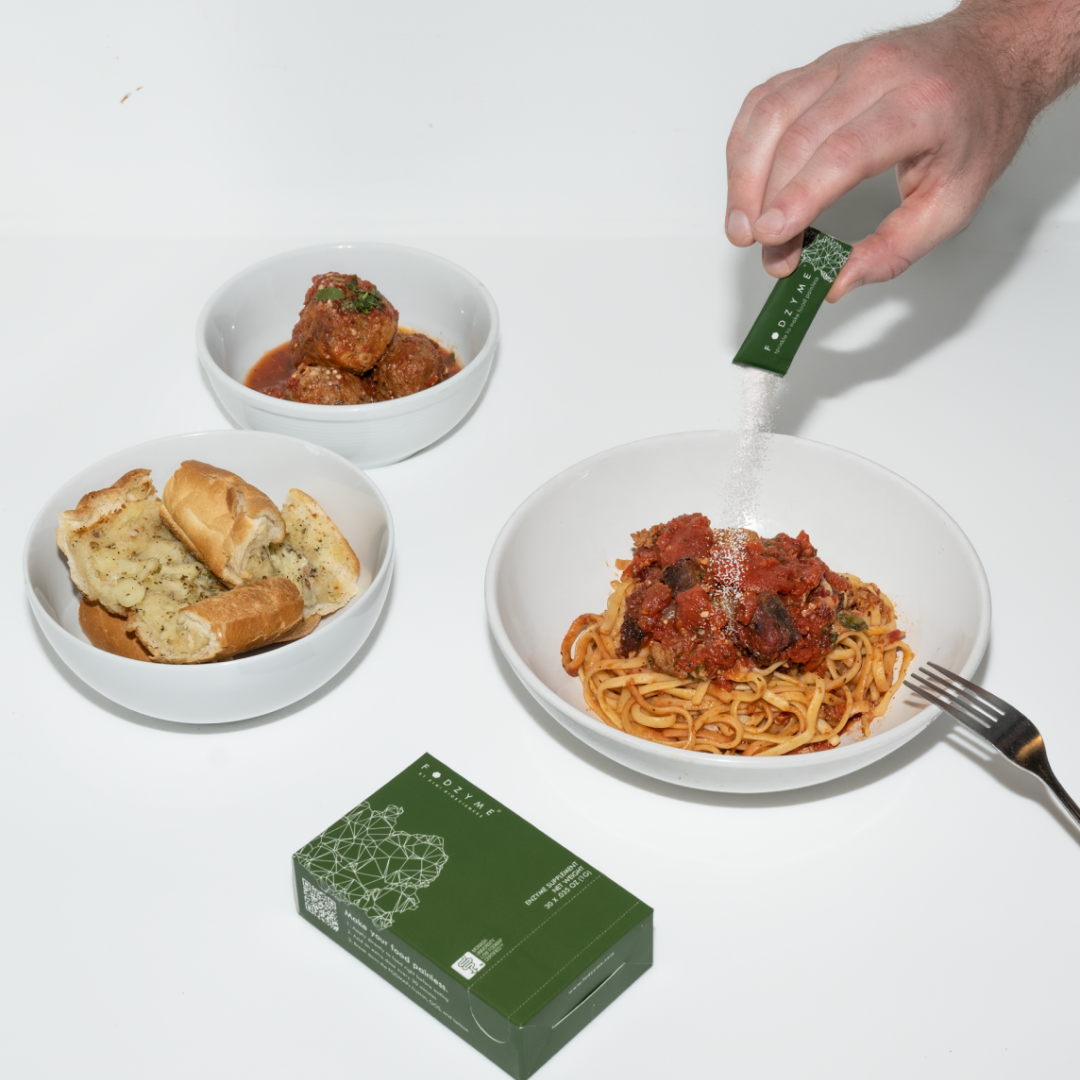Reintroducing FODMAPs and how enzymes may help you
The key detail here is to carefully track every challenge and its outcomes, including your tolerance levels to each of the FODMAP foods and the symptoms you experience.

As you may already know, a low FODMAP diet consists of several phases. Each one as important as the next, these phases are designed to help you identify your personal thresholds when it comes to trigger foods and your body’s reaction to different FODMAP groups, as well as help you manage these reactions effectively.
The three phases of a low-FODMAP diet
1. Elimination phase
During the elimination phase, which usually has to last from 2-6 weeks, you are recommended to replace high-FODMAP foods with particular low-FODMAP alternatives.
2. Reintroduction phase
This phase is where you can turn science into art, creating a highly individual approach to determine your tolerance levels to high-FODMAP foods.
Lasting from 8-12 weeks, this phase requires you to start reintroducing high-FODMAP foods into your diet, one FODMAP group, or on a more granular level, one food at a time. Think about it as a series of challenges for your gut.
The trick here is to give your body enough time to ‘deal with’ the certain foods, so it is best to have 2-3 days between each food reintroduction. During this time, you need to increase the serving size of the same food in order to test your thresholds.
3. Integration phase
This is where you’re not given many options. Once you identify your trigger foods and tolerance thresholds, there isn’t much that your doctor can recommend apart from figuring out a balance between those thresholds and avoidance. In the long term, it’s a balance between your tolerated FODMAP-rich foods and the avoidance of others.
But let us back up a bit, and return to the reintroduction phase. Many of us witness a huge impact on symptoms and general wellbeing at the elimination phase, and too many of us decide to comfortably stay in phase one. In this case, ‘comfortable’ means having to avoid major groups of delicious, nutritious foods. These foods are not only hard to deny yourself, but also, at times, impossible to avoid. This especially applies to social occasions, eating out, and anything that doesn’t involve you making everything from scratch.
The problem with staying in the elimination phase, however, does not only have a social aspect. It also deprives your body of essential nutrients that are hard to find in low-FODMAP alternatives.

There are several reasons FODMAP reintroduction is important:
Determine your thresholds
You can learn to prevent the symptoms while still being able to eat your trigger foods in smaller portions.
Take care of your microbiome
Research shows that reducing FODMAPs long-term can change the environment of your microbiome in absence of prebiotics and fiber, which feed the bacteria that need to remain in the colon.
Add variety
Instead of eating under the daily norm of calories, you will be able to get the calcium, iron, and fiber your body needs, as well as get to the total calorie goal for the day.
Establish a healthier relationship with food
Reintroducing some foods can break the barrier to a healthy relationship with food.
When and how to reintroduce FODMAPs
While the question is extremely individual, there are a few things you should know. Once you get your symptoms under control during the elimination phase, you need to remain on the low FODMAP diet during the series of challenges.
The key detail here is to carefully track every challenge and its outcomes, including your tolerance levels to each of the FODMAP foods and the symptoms you experience.
Key tips to adhere to:
- Remain on the low-FODMAP diet
- Keep each FODMAP group separately
- Be cautious of stacking
- Test FODMAP doses within a 4-hour window
What are the different FODMAP groups?
While you may be aware of the different FODMAP groups, it’s important to test your tolerance levels with specific foods that don’t have a mix of these groups within them. Below are the examples of high-FODMAP foods with their respective FODMAP groups, that don’t contain group overlapping.
- Lactose: dairy products
- Fructose: honey
- Sorbitol: apricots and peaches
- Mannitol: Portobello mushrooms
- GOS (galacto-oligosaccharides): almonds
- Fructans: (wheat) bread, (fruit) grapefruit, apples, etc., onion, garlic
There is a reason why fructan is one of the most common troublemakers within FODMAPs. Foods can usually contain a mixture of fructans and it is rather difficult to measure the exact mix of every type of fructan in a food.
As such, it can cause symptoms in many of us due to the compounding of different fructan subtypes. So instead, looking at ‘total fructans’ is going to work better when quantifying these foods.
Integration phase and how to take it further
Once your triggers and thresholds are identified and you’re comfortable in knowing how to manage them, there isn’t a lot of advice out there on how to manage this long-term. For some of us, it’s more manageable than others, yet restricting these food groups for good can be a challenge.
Enzymes as an approach to the problem food
While you may be familiar with enzymes, it may not be extremely clear as to how they can help and, more importantly, what enzymes you need to take to make them work for you. Let’s take a step back.
Enzymes are proteins that regulate the rate at which a plethora of metabolic and chemical processes occur in our bodies.
Often referred to as biological catalysts, enzymes are highly specialized proteins that act on a specific molecule, called the enzyme's substrate. One instance some of us are familiar with is when specific digestive enzymes break down the various components such as carbohydrates, fats, and proteins in the food we eat. This process allows our bodies to absorb the nutrients it offers and turn them into energy.

How enzymes can help us
- Prevent the effect of FODMAPs on the digestive system like digestive discomfort, pain, or other symptoms
- Help you receive the nutritional benefits from foods that otherwise you might avoid
- Enable gastronomical diversity and allow you to lift the restrictions placed by the low FODMAP diet
While fast-fermentable fibers like FODMAPs promote gut health they can also cause trouble for people with increased gut sensitivities. An enzymatic approach can enable people to receive nutritional benefits without having digestive discomfort, pain, or other symptoms.
An enzyme isn’t meant for your body. Instead, it’s for the food your body has trouble digesting.
FODZYME’s enzyme blend
FODZYME® is the world's first enzyme blend to directly tackle the FODMAPs fructan, GOS, and lactose. If you are wondering about polyols, we are working on a novel polyol-targeting enzyme as we speak. Our enzymes are very specialized proteins produced by microorganisms that break down specific substrates, in this case, FODMAP molecules.
- Breaks down FODMAPs as you digest your meal, effectively eliminating FODMAPs in your gut
- Contains fructan hydrolase (acts on fructan), alpha-galactosidase (acts on GOS), and lactase (acts on lactose)
- Comes in powder form for maximum integration with high-FODMAP foods
Science behind FODZYME
FODZYME® was administered concurrently with 3g of inulin (a common source of fructan) in SHIME®, a multi-compartment scientifically validated model of the complete human gut, to study the efficacy of FODZYME’s fructan hydrolase in fructan degradation.
Lactase and alpha-galactosidase, the two other enzymes in FODZYME’s formulation, were assessed as an additional control arm to verify the specificity of fructan hydrolase in fructan hydrolysis.
Findings indicated a rapid breakdown of fructan to fructose in gastric conditions with ~90% of the inulin mass converted to fructose within 30 minutes thus demonstrating resilience to both gastric pH and protease activity. The study also showed that 70% of fructose was absorbed during the simulated small intestinal transit, thus reducing gas.
You can learn more in the clinical brief here.
If you’d like to make enzymes work on your food, try FODZYME via the links below.

FODZYME Enzyme Supplement
FODZYME® breaks down FODMAPs fructan, lactose, and GOS, helping you enjoy your favorite meals with confidence and giving your body the nutrients it deserves.

